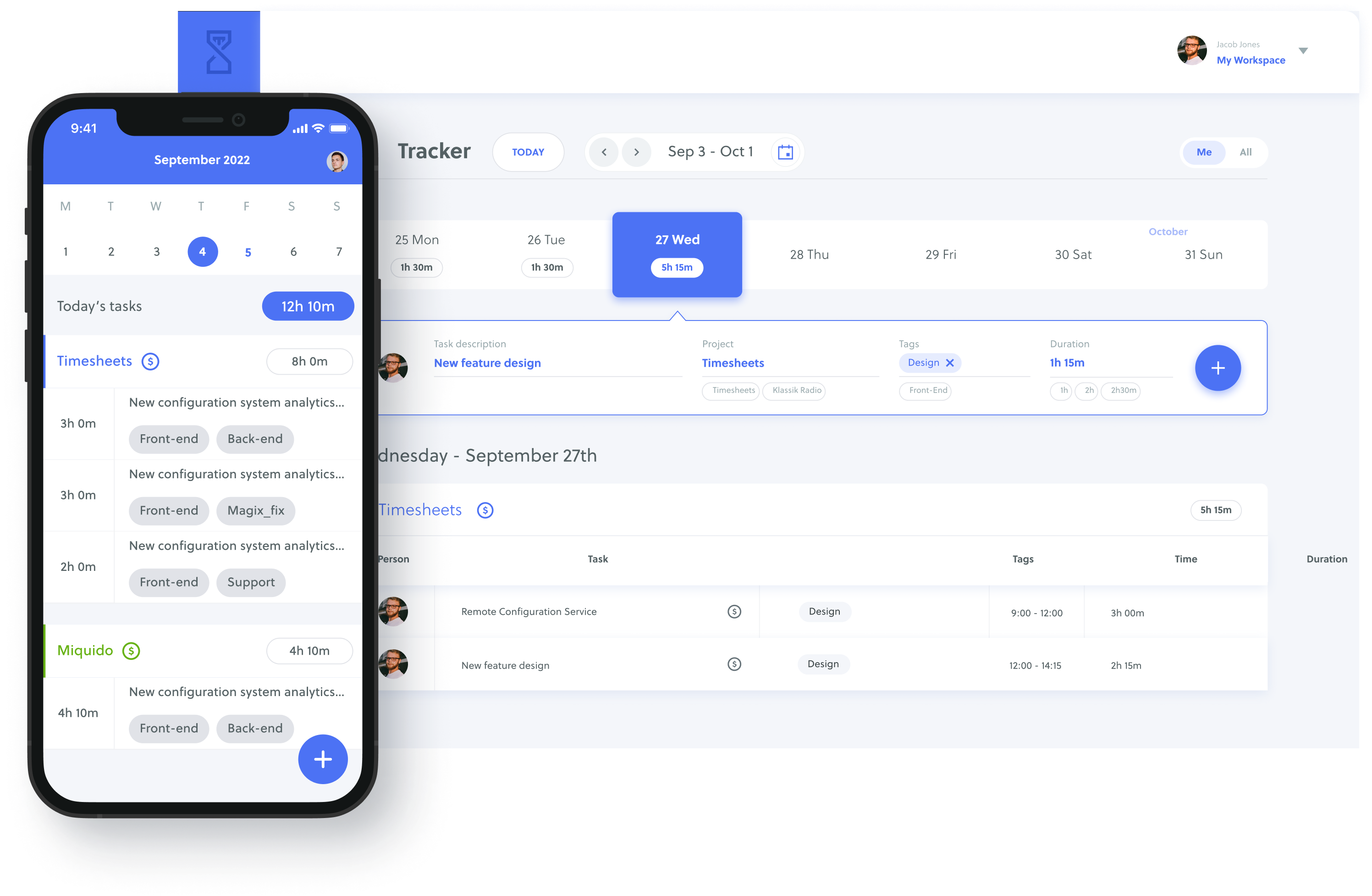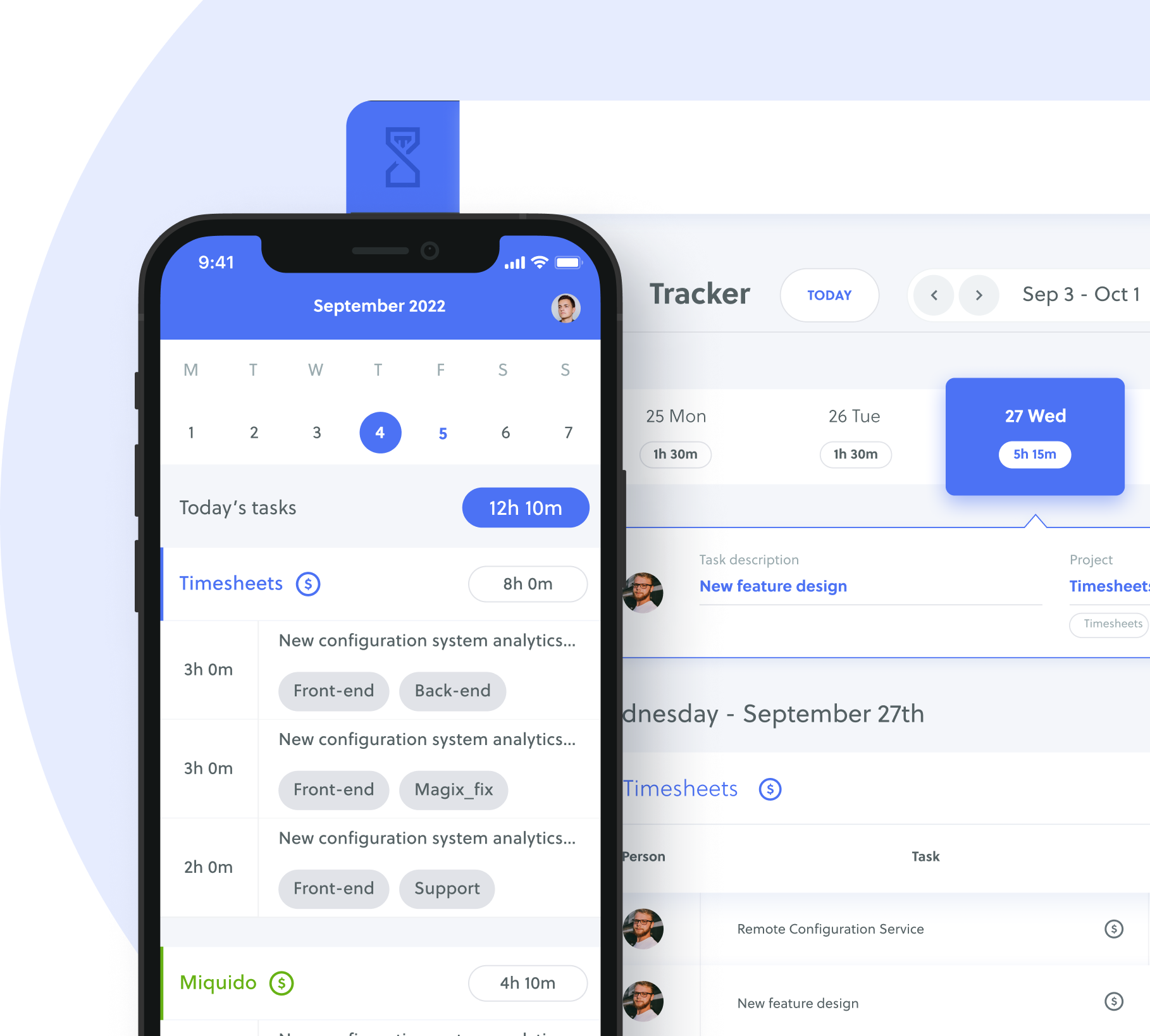Work schedules are essential if you intend to run your business efficiently. Typically, a work schedule helps you organize when employees work and how they rotate working hours. This is particularly useful if you manage a large team or operate a business that always requires people to be around.
In this article, we’ll discuss different types of employee work schedules, why a work schedule is essential, and how to choose the best one for your team.
Table of Contents
What Is a Work Schedule?
A work schedule is a well-detailed plan that indicates the particular days and times employees are expected to carry out their work-related duties.
The work schedule specifies the total number of days and hours each of your employees will be working. A comprehensive work schedule also includes details like the work location, shifts, and duties to be performed within a specific period.
Types of Work Schedules
There are various types of work schedules that you can use for your company. Each of them has a unique set of benefits and flexibility.
So, when choosing a schedule, you need to select one that satisfies your company’s needs and accommodates the number of employees you have. You’ll also need to consider the legal requirements in your state of operation.
Now, let’s look at 14 different types of schedules you can adopt.
Full-Time Work Schedule
A full-time work schedule typically requires working 40 hours per week. However, this depends on the industry or position in question. For some, it can be less than 40 hours weekly. For example, with the IRS, full-time work covers work done for 30 hours or more a week.
On the other hand, the Bureau of Labor Statistics considers 35 hours a week as the ideal full-time work.
That said, there are various variations of the full-time schedule. For example, there’s the 4/10 work schedule where employees work for 10 hours, 4 days a week instead of 8 hours every weekday.
An example of a full-time work schedule is the regular 9 AM – 5 PM work time on weekdays, as shown in the example below. This could be an in-house sales rep who works 8hrs on Monday to Friday.
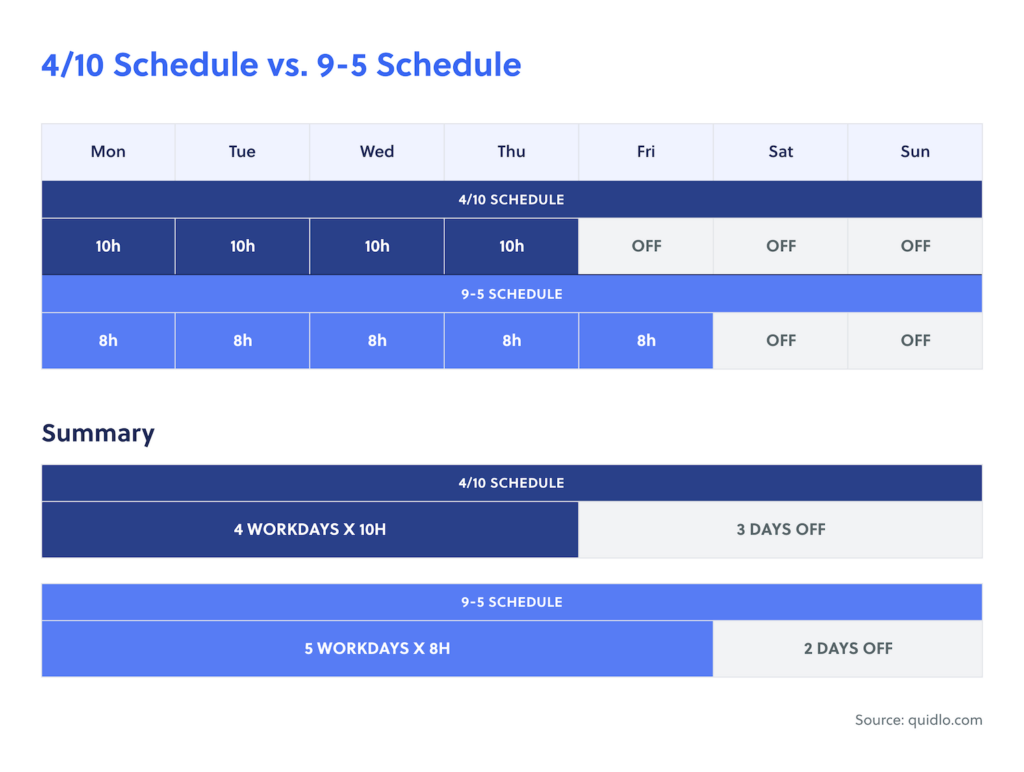
One advantage of full-time schedules is the stability they bring to you and your employees. This is because the employee works on the same days and hours.
Also, the monthly salary is fixed. So it’s easier to determine your employee’s earnings. Additionally, due to the long hours—full-time employees are privy to benefits like health insurance, retirement benefits, vacation packages, etc.
Some disadvantages include the tendency for employees to be overworked. Also, employees may not have ample breaks compared to the amount of work they do.
Part-Time Work Schedule
A part-time work schedule is one where employees work for fewer hours compared to a full-time schedule. Part-time work schedules are for jobs with light workloads or where a full-time employee is not necessary.
This work schedule is common in the retail, hospitality, and manufacturing industries. It’s often less than 35 hours or 40 hours weekly (depending on how your company counts full-time work).
Part-time work schedules have more flexibility than full-time schedules as well. For example, with the part-time work schedule, employees don’t have to work every day of the week.
For example, the schedule could allow an employee to work only on Mondays-Wednesdays from 9:00 AM – 2:00 PM. However, not all part-time schedules are this consistent. There could also be time variations, for instance, 1:00 PM – 5:00 PM on Friday and 9:00 AM – 1:00 PM on Tuesday.
Here’s an excellent example for bookstore attendants:
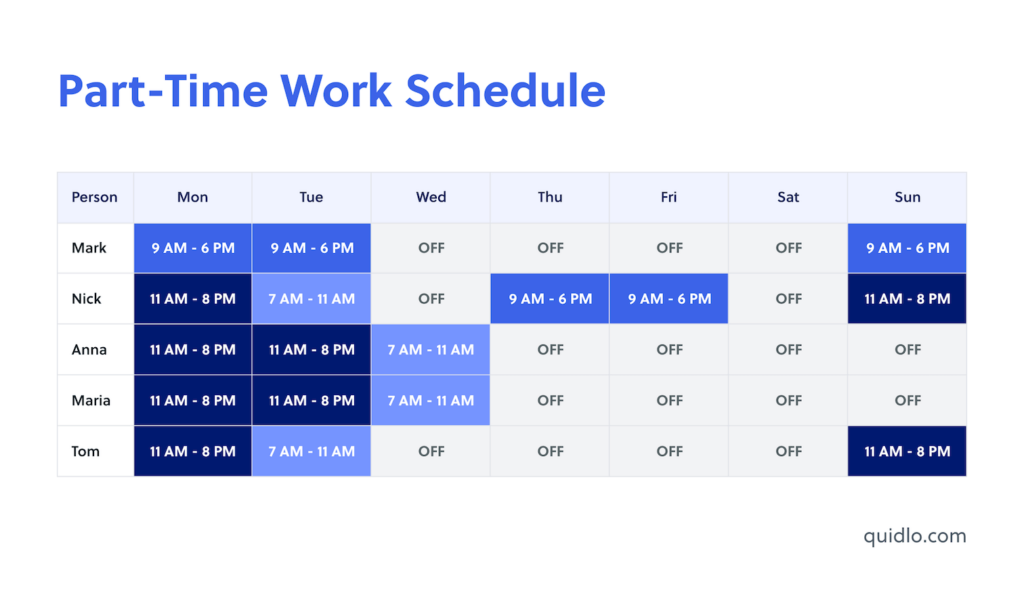
One significant downside to the part-time work schedule is its inconsistency. Also, part-time employees don’t get access to the same benefits as full-time employees. This would be an advantage for the employer because it saves labor costs.
Fixed Work Schedule
On a fixed work schedule, employees work for the same number of days (working days) and hours weekly. This is best in companies with fixed opening and closing hours and requires employees to be present during these hours.
Fixed schedules may be used for full-time or part-time work requirements. For example, with a full-time arrangement, it could be from 8:00 AM – 4:00 PM, Monday – Friday. With a part-time schedule, it could be 12:00 PM – 4:00 PM, Thursday – Saturday.
Typically, working hours are predetermined and decided by the employee and employer. Then, a work schedule is created accordingly.
A fixed schedule makes it easier to calculate work hours and ascertain labor costs. It’s also less complex than other types of work schedules.
Flexible Work Schedule
As the name implies, the flexible work schedule is “flexible.” Here’s how: The employer and employee determine the required work hours, but these hours count based on when the employee arrives and leaves the workplace.
For example, employees may be required to work for 7 hours a day. So, the employee can work from 9:00 AM to 4:00 PM on Monday, 10:00 AM to 5:00 PM on Tuesday, and so on.
The flexible work schedule, also called flextime, works for full-time and part-time job roles. It is particularly effective if your business does not demand that all employees be present at the same time.
A typical example could be an in-house digital marketer who is expected to work 8 hours daily without any specified time range. The flexible work schedule can also permit employees to begin their work in-office and complete it elsewhere.
A flexible work schedule allows your employees to have a better work-life balance. It’s also one way to ensure that employees are more productive by giving them the liberty to work when they are more effective.
Also, although employees choose when they work, they still complete the required work hours. Therefore, this does not lead to any loss on your part as the employer.
On the downside, it may be hard to have strategic team meetings, especially when some team members are not present. However, this can be resolved by ensuring all meetings are set at specific times and communicated to all employees in advance.
Shift Schedule
Shift schedules are often used by businesses that operate round-the-clock. Here, the employee work times are assigned on a rotational basis. This can be split into morning, afternoon, and night shifts. Or morning and night shifts.
It’s used in convenience stores, manufacturing, transportation, restaurants, hotels, and similar businesses.
A good example is a hotel where the attendants work three shifts. The first is by 6:00 AM – 2: 00 PM, the second is by 2:00 PM – 10:00 PM, and the third is by 10:00 PM – 6:00 AM.
The benefit of the shift schedule is it ensures business operations are not interrupted, and there will always be someone to attend to customers.
Rotating Shift Work Schedule
The rotating shift schedule is a variation of the shift schedule discussed above. With the rotating schedule, employees work based on a predetermined series of day and night shifts. It’s also commonly used by businesses that recruit 24/7 operations.
So, for example, if an employee works morning shifts in a particular week, they will be scheduled for night shifts in the following week. Then an afternoon shift in the next, and the rotation continues in that manner.
Here’s a visual example:
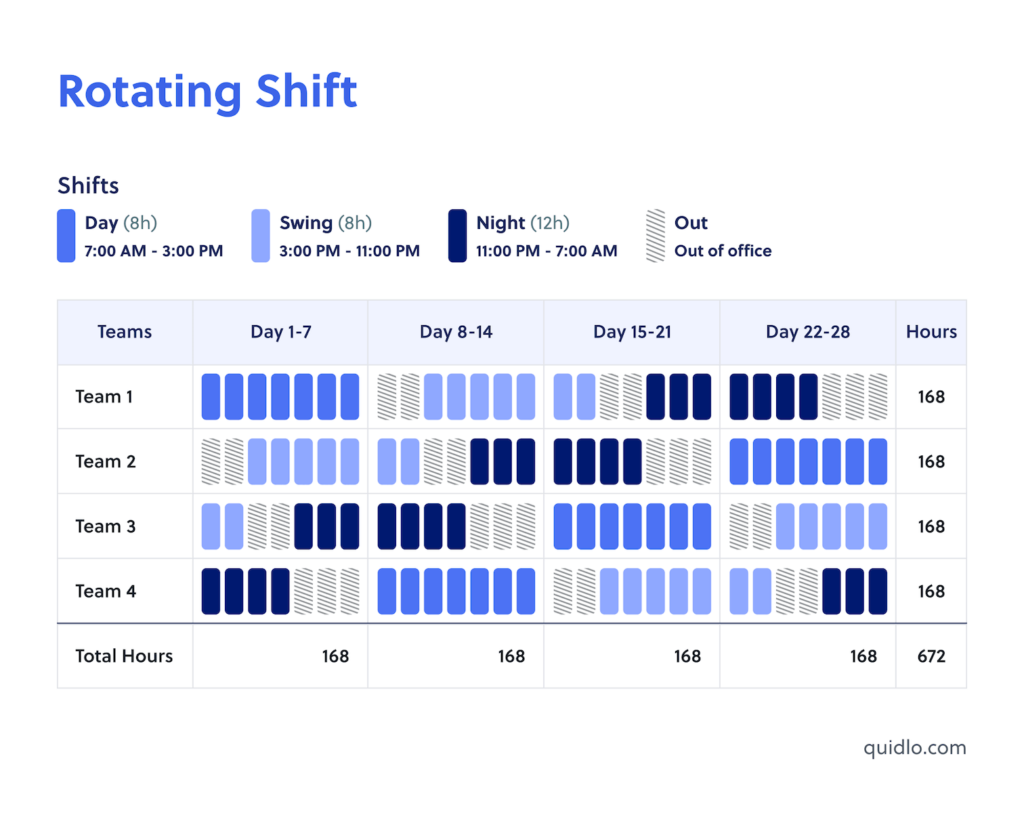
In the above image, Team 1 works the day shift from days 1-7, the swing shift from days 8-14, and the night shift from days 15-28. A similar pattern is followed for teams 2, 3, and 4.
The rotating shift work schedule aims to ensure a balanced distribution of how employee shifts are assigned. Some common types of rotating shift work schedules include the 2-2-3 work schedule, Dupont schedule, and pitman’s schedule.
Split Work Schedule
With the split work schedule, a work day is divided into two or three parts (or time blocks). This means that an employee works within a specific time period, say 3 hours a day, and clocks out. Then resumes for another couple of hours on the same day.
For example, the employee works from 8:00 AM to 11:00 AM, takes a break for 3 hours, and resumes from 2:00 PM to 5:00 PM. In certain instances, the employee may be assigned to different functions at each time block. Here’s an example:
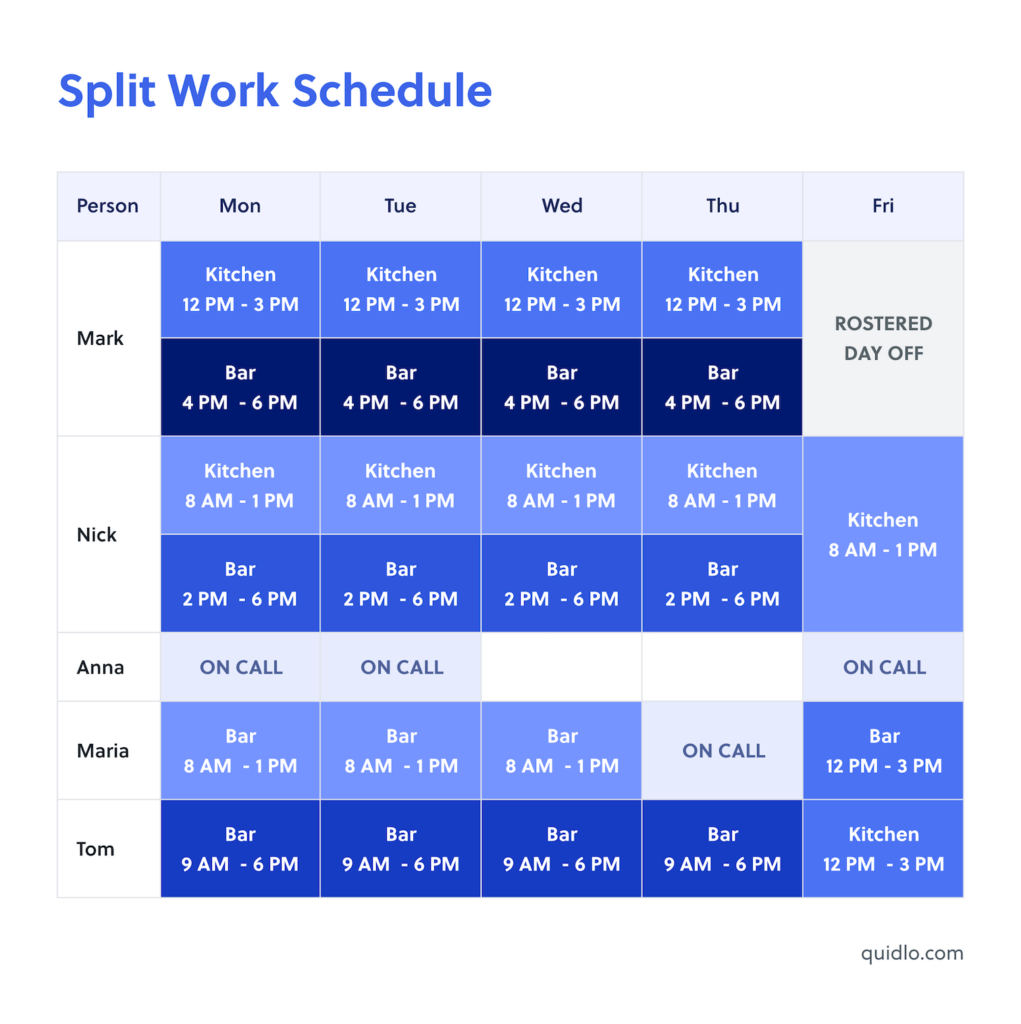
Split shifts are helpful for individuals who want more flexibility with their workdays. An advantage of the split work schedule is that you can hire only a few employees.
Instead, you can maximize your best hands by letting them work within hours when your business demands or customers are high. Then, let them take time off when there is little to no demand from your customers.
Finally, when using the split shift work schedule, you need to be aware of labor laws governing business operations in your state and the number of hours they require between shifts.
Irregular Work Schedule
Simply put, an irregular work schedule is one in which employees work at varying times during the week. The employee shifts change based on the business needs.
According to the Economic Policy Institute (EPI), irregular work schedules are typical in industries such as transportation, communications, agriculture, recreation, and finance, among others.
This work schedule is not advisable if you want to achieve a more stable and consistent work pattern. An irregular work schedule also makes it difficult for employees to make plans for other aspects of their lives.
Further, with irregular schedules, employees may not get early notifications about when they’ll be working, which may cause them not to bring in their best.
Seasonal Schedule
A seasonal work schedule covers only a few months in a year. They particularly apply to special seasons like holidays and specific periods in a year when business gets busy.
For instance, a gift shop creates a seasonal schedule during the Christmas holidays because they’ll get more customers within that period.
This schedule can also be useful for manufacturing companies that may need to double their production during these special seasons.
The advantage of seasonal schedules is that they help you manage your business effectively, even when there is a rush. For the employees, it may be another way to earn extra income.
On the downside, with seasonal schedules, you cannot guarantee which of your employees will be available the next time you need them. Typically, in cases where you may need to hire or rehire people, some of them may move on before the next busy season.
Compressed Schedule
With a compressed work schedule, employees work longer hours than the regular 9-5 every weekday. Instead, they take a weekday off. For instance, employees will work 9 hours for four weekdays. So, an employee can work 8:00 AM – 6:00 PM from Monday – Thursday. Then take Friday off.
Simply put, 40 hours of full-time work is “compressed” into four days instead of five. This is otherwise called the 4/10 schedule.
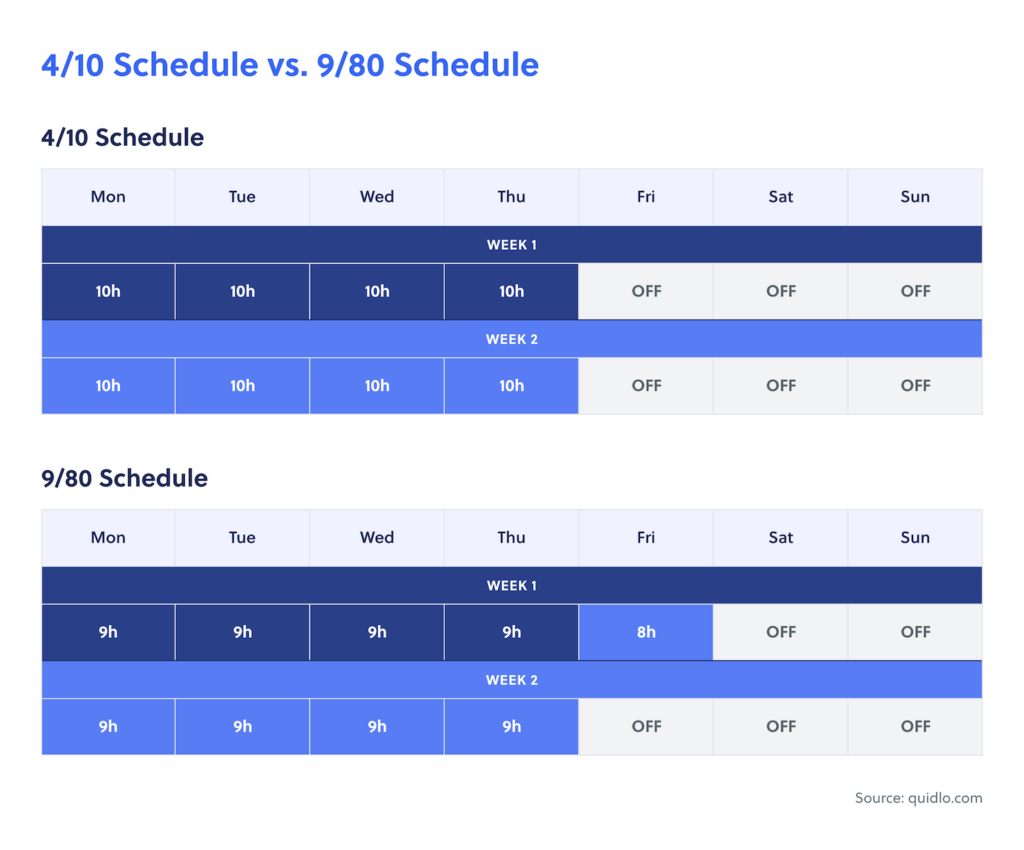
With the compressed schedule, employees get fixed work hours, making planning easier for the employer and employee. The employer can easily determine labor costs at the end of the month, and the employee can easily plan their activities around the work schedule.
The 9/80 schedule is a type of compressed schedule that shrinks 80 hours of work into nine work days instead of 10. The major disadvantage of this schedule is that employees typically work long hours, which can easily lead to burnout.
Overtime Schedule
Overtime schedules come in when you need employees to go over the full-time work hours (i.e., 35 – 40 hours weekly). This mostly happens when there is a big project or work demands are higher than usual.
However, you should remember that working with an overtime schedule means that employees will be paid for the extra hours they spend on the job.
According to the Fair Labor Standards Act (FLSA), employees who work overtime must receive not less than the time worked and one-half of their regular pay rates— i.e., overtime hours x 1.5 x regular pay rate.
To avoid running over with the cost of extra hours, it’s advisable to use only a few of your employees for overtime hours. When using an overtime schedule, be sure to get an accurate estimate of how long the work will take.
On-call Schedule
An on-call schedule is one in which an employee is available on demand by the employer. The on-call schedule is useful for urgent work needs.
In the tech and IT environment, for instance, an on-call work schedule requires some developers and software engineers to be available at all times. This is in case there’s a need for quick bug fixes, system reboots, downtimes, security breaches, and so on.
The on-call schedule is quite common in the medical sector, whereby nurses and doctors must be available if an emergency arises.
Where applicable, it’s advisable to rotate on-call shifts to give your employees some balance. This simply means that the same people should not always be on call.
For instance, if you have a team of 10, you can ensure that at least two people get on-call duties once a week or month, as the work requires.
Hybrid Work Schedule
A hybrid work schedule accommodates working remotely and working from the office. The hybrid schedule is flexible, allowing employees to choose where and how they work.
There are different variations of the hybrid work schedule, but here’s a simple breakdown of some of them:
The at-will schedule or remote-centric schedule – where there is no strict schedule and the employee chooses when they come to the office and when they work remotely.
The hybrid split-week – here, the employer assigns specific days of the week for a team of employees to work from the office. So, for example, the marketing team comes in on Mondays, the Sales team works from the office on Tuesdays, the Customer service team works on Wednesdays, and so on.
The week-by-week hybrid schedule – employees work from the office for one week and remotely for several weeks.
The beauty of this hybrid schedule is that it accommodates remote and office work, provides more flexibility and gives employees a good work-life balance.
Remote Work Schedule
In this schedule, the employers require the employees to work a specific number of hours daily. The remote work schedule can have fixed working hours. In this case, employees work within a predetermined time block, e.g., 8:00 AM – 4:00 PM.
In other cases, employees choose when they work to hit the predetermined hours. That is, they decide their start and end times. As a result, employees can personalize their work hours and schedule tasks for when they are most productive.
A remote work schedule works best for organizations that operate a large remote team. In some cases, these team members operate from different countries or time zones. So, the remote schedule is one way to accommodate these time variations.
An obvious advantage of the remote work schedule is its flexibility. Like the hybrid schedule, if you work with a remote schedule, you must ensure that you have all the tools to make your team effective. These tools include time trackers, cloud storage, project management software, and communication platforms.
What Is the Most Common Work Schedule?
The most common work schedule is the 9-5 full-time schedule, where employees work 8 hours daily from Monday to Friday. With this schedule, the standard 40 hours a week is easily achievable.
However, we’ve looked at different types of schedules and seen the uniqueness in all of them. So it’s safe to say that it’s not always a one-size-fits-all affair when creating work schedules for your company. Typically, different industries will have certain schedules that work best for them.
Let’s have a look at what works for the following five key industries:
Healthcare – Since healthcare facilities like hospitals, veterinary clinics, scanning centers, etc. require regular staffing, work schedules like the shift schedule, rotating shift schedule, and on-call schedule are quite effective.
Technology – Technological establishments are quite vast and need hands-on operations most of the time. For instance, systems must keep running, and security checks should not be compromised. So, flexible work schedules, hybrid work schedules, remote work schedules, and shift schedules are recommended options.
Construction – Typical work schedules for the construction industry include shift schedules, irregular work schedules, part-time work schedules (when working with artisans), on-call schedules, and split work schedules.
Retail – For retail businesses like supermarkets, convenience stores, department stores, and so on, work schedules like the rotating shift schedule, part-time schedule, full-time schedule, fixed work schedule, and seasonal schedules are advised.
Manufacturing – Manufacturing businesses often carry out large-scale productions. For efficient operations, you can work with shift schedules, full-time schedules, rotating shift work schedules, part-time work schedules, on-call schedules, or fixed work schedules.
All that said, there is no strict rule to creating a work schedule, so you may choose to mix two or more schedules depending on how they suit your establishment. For example, you could have a full-time schedule for one department and on-call schedules for another.
Why is Employee Work Scheduling Important?
Employee work scheduling is crucial to the smooth running of your business and should not be ignored. It’s also an effective way to ensure you do not violate labor laws governing your business operations.
Without careful scheduling, you may subject employees to an 80-hour work week and not even notice.
Essentially, a well-organized work schedule will ensure that:
Your employees know when to work and what is expected of them. This way, they can plan accordingly to bring their A-game at work and have a well-balanced life.
You do not overwhelm your workforce. In turn, employees maintain a good frame of mind, a positive attitude to work, and better productivity.
Your business operations don’t suffer due to the absence of workers when needed. There is a schedule that controls the system.
Payrolls are easier to ascertain at the end of a specific work period.
Also, creating a work schedule is one way to ensure there is more accountability in your workforce. It also helps to manage your employees more effectively as there is a way to track who is available and when they are available.
How To Determine the Optimal Work Schedule?
Setting a work schedule that guides your business operations is an important task, and you want to ensure that you’re getting it right. To do this, here are some key questions to ask:
Does the schedule fit your industry and the nature of your business activities?
Is it effective and practical for your peak hours and the mode of operation?
What type of team do you have? Is it a remote team, hybrid, or in-office workforce?
Does it allow your employees to have a work-life balance?
Is it evenly distributed? While you want to build around your best employees, you also want to ensure the schedules are evenly distributed.
Does it accommodate the tools you use and the maintenance they need?
If you can answer these questions, choosing a work schedule that fits your business and its needs becomes easy. Remember, it’s okay to ask questions after choosing a schedule and make adjustments when needed.
In closing
Creating efficient work schedules may seem hard to crack, but they are so crucial for your business to run effectively. In this article, we looked at 14 types of work schedules and showed you how to choose one that works for your business.
These schedules include the full-time work schedule, part-time schedule, fixed work schedule, flexible schedule, shift schedule, rotating shift schedule, split work schedule, irregular schedule, seasonal schedule, and compressed schedule.
We also looked at overtime, on-call, hybrid, and remote work schedules, each with unique applications.
Choosing one that works for you requires a thorough consideration of your business needs and activities.
So, now that you have this foolproof guide to the various types of work schedules and how to choose the best one, go ahead to create one for your business. All the best!






